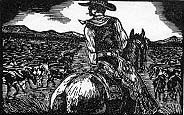American Cinema, #4: The Western
When John Sturgeses, director of The Magnificient Seven, introduces the western hero and our response to him, he uses the language of Oedipus the King: "I'm the one that can do it. Everybody else tries, but turn to me. I can solve it for you. . . ." Sturgeses knows that heroes may indeed die violently, but they may also acheive apotheosis: "They want to be the legend."But in Westerns, heroes must share the fame. There are two stars in the Western, the hero and the vast, open landscape. The landscape and the hero often exhibit the same quality--they are enduring. See Jane Tompkins' essay "Language and Landscape" for a discussion of the value system in place in the opening shot of Westerns.
The early Westerns romanticized the West. Writers and directors created thrilling tales of adventure, Mythopoeia. Anyone who lived in the real West knew that it was not all that romantic. See William Kittredge's essay, "Death of a Western."
1930s: Western heroes are one-dimensional, acting out uncomplicated themes of right and wrong. These films are primarily (if not completely) morality tales. If movies could be religion, then the Western would be our preacher.
1940s: continued moral and historical value. Tales of development and progress, the frontier transformed into a modern city. My Darling Clemetine (1946) tells the story of Wyatt Earp, who like the town of Tombstone itself, is being pulled away from his wilderness roots towards culture by Clemetine, a refined woman of the East. This is analogous to the prototypical story of Enkidu. For a discussion of the casting of the daulity between Culture/ wildness in female archetypes in the West see Julie Levinson's "Genre and Gender."
The Western has three basic elements: 1.) Setting defined by transition or opposition between the old world and the new world as shown in My Darling Clemetine and Lonely are the Brave. 2.) Hero defined by a frontier figure or figures, often with wilderness or civilized counterparts, who move or are caught between the two worlds. 3.) Narrative defined by "progress" where the hero's destiny resolves or dramatizes conflicts between the old world and the new world usually through some form of achieved or failed metamorphosis.
1950s: Westerns explore a wide variety of themes; westerns shape Cold War ideology. John Wayne epitomizes the American character. Red River (1948) also gives us strong female characters, but the Western is probably not the best genre for promoting the institution of marriage. The male heroes are loners and reluctant. High Noon (1952) gives us the basic philosophy of American life. "It's not my problem and I'm not going to get involved." In 1959, Rio Bravo exalted individualism and professionalism; the hero doesn't want or need help from the community because most folks are incapable of acting in a sufficiently violent manner.
1960s: The Western starts to get interesting; the myth of the West begins to turn sour. We learn that the kind of heroic code we have lived with and admired--a certain kind of psychology and behavior--is frightening, even destructive (sounds like Achilles). The Western looks at changes in cultural values. The western hero can no longer exercise his heroic code without some measure of tragic vision.
The Magnificent Seven (1960) explores the tragic side of the cowboy hero. The quest for freedom and individuality is also the story of inhumane conquest. The cowboy hero is eroded by irony. Westerns become reflexive, showing that the image does not match reality--The Left Handed Gun.
1970s: The Western becomes the genre for processing crucial social problems and cultural concerns. The myth of freedom is represented by the outlaw. Pat Garrett and Billy the Kid (1973) explores the theme of freedom in a time of transition. The Western conceives of society in more and more sophisticated terms, and as society becomes more sophisticated it becomes more corrupt. Films like Little Big Man (1970) begin to reexamine the role of the Indian in the history of the West. The film epitomizes Aristotle's notion of the reversal and recognition. Westerns in the forties and fifties were (for the most part) covering up a history of genocide.
John Wayne's last film The Shootist suggests that the frontier code is out of place--even dangerous--in the turn of the century West
Dances with Wolves (1990) suggests that the Western still functions as a genre for reevaluated American culture; the film also proposes that the American West is a place where heroes can reinvent themselves. The hero can become somebody entirely new--a man of honor, battling the corrupt and racist values of the myth of state. This time audiences cheer as the Indians defeat the U. S. Cavalry.
Clint Eastwood's Unforgiven (1992) attacks every notion of heroism in the West and suggests that the great American art form is now representing American schizophrenia.
The documentary ends with the suggestion that we are between myths in this country.
